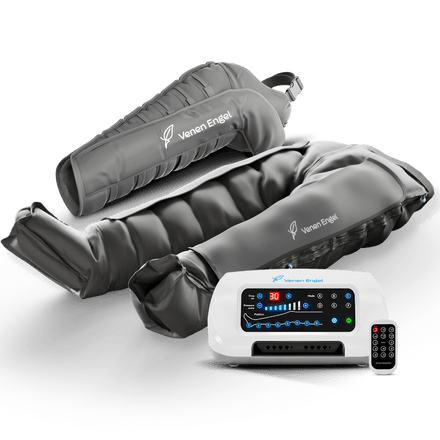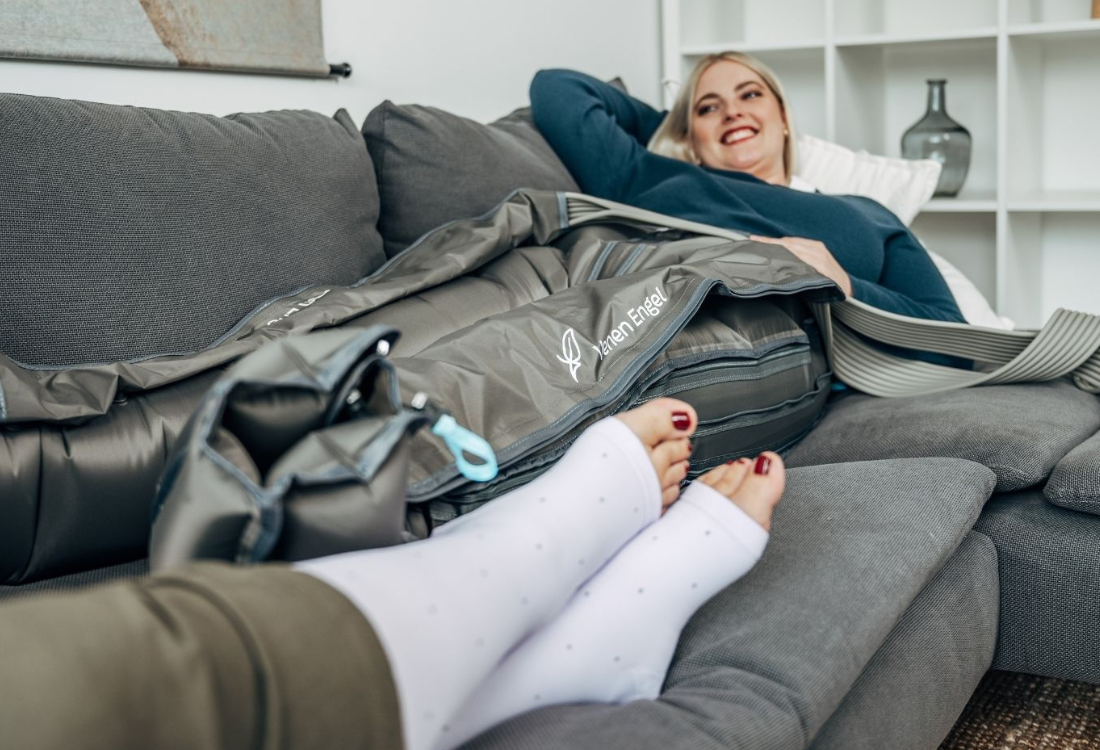
Prevent swelling & improve blood circulation
A long day in the office or standing can lead to swollen legs and feet. This happens because blood and fluids stagnate and accumulate in the lower extremities. Compression stockings exert targeted pressure on the legs, which helps to promote blood circulation and reduce fluid retention. This prevents swelling and allows you to feel more comfortable throughout the day.
Good blood circulation is crucial for your overall health and well-being. At work, especially in activities that require prolonged sitting or standing, blood circulation can easily be affected. Compression socks support vein function by pumping blood back to the heart, improving circulation. This reduces the risk of varicose veins and thrombosis and helps you stay more energised and focused.
Compression stockings for standing professions
Compression stockings are particularly beneficial for jobs that require standing for long periods of time. They provide support and relieve the strain on the veins, reducing pain and swelling. This is particularly important for people in the catering, retail or healthcare industries, where standing for long hours is often the order of the day.
Requirements for legs in the catering, retail and care sectors
Jobs in the catering, retail, healthcare and care sectors are often very physically demanding. The legs in particular are put under a lot of strain in these professions. Here are the specific requirements and challenges for each area:In catering, long working hours and intensive walking and standing are the order of the day. Staff are constantly on their feet, often without long breaks.
A day in the catering industryThe day starts early by preparing the restaurant for the guests: Arranging tables and chairs and setting the tables. During service times, people run back and forth to take orders, serve food and clear tables. The work is often hectic, especially during peak times such as lunch and dinner. Breaks are rare and short. Challenges:
In retail, employees also spend a lot of time on their feet. This mainly involves standing at the checkout and walking around the shop to help customers or restock shelves.
A day in retailThe working day begins with stocking the shelves and organising the warehouse. The majority of the day is spent on the sales floor, advising customers, presenting products and possibly transporting heavy goods. Standing or walking at the checkout, payments are taken and purchases are packed. Challenges:
In the care sector, the demands on the legs are particularly high. Nursing staff and doctors often have to work long shifts that require intensive physical labour.
A day in nursing
The working day begins with the morning care of patients, which includes lifting and repositioning patients. Carers spend the rest of the day administering medication, changing dressings and assisting with everyday tasks such as going to the toilet or eating. They often have to deal with emergencies that require a quick response and intense physical exertion.
Jobs in the catering, retail, health and care sectors place high demands on the legs. Standing and walking for long periods and carrying heavy loads are typical challenges that can lead to physical complaints.
Tips for everyday working life
Compression stockings and targeted exercises can make a significant contribution to reducing the strain on the legs in professions such as catering, retail and the health and care sector
.
Compression stockings exert pressure on the legs, which decreases from the ankle region upwards. This promotes blood circulation and reduces the strain on the legs.
Recommended exercises for the legs In addition to wearing compression stockings, regular exercises can help to strengthen the muscles, promote blood circulation and maintain flexibility.
- Foot circles: While sitting or standing, lift one foot off the floor and slowly circle the foot clockwise and then anti-clockwise. This promotes blood circulation and loosens the ankle joints. Calf raises: Stand up on your toes and slowly lower yourself back down. This can be repeated several times and strengthens the calf muscles, which are important for blood circulation.Sitting leg raises: Sit down, stretch one leg straight out in front of you and then slowly lower it again. Do this alternately with both legs. This exercise strengthens the thigh muscles and promotes blood circulation.Stretching the thighs and calves: Standing up, bend one leg backwards and pull the foot towards the buttocks to stretch the thigh muscles. For the calves, you can lean against a wall with your hands, stretch one leg backwards and press your heel towards the floor.Toe curls: Curl your toes together while sitting and relax them again. This promotes blood circulation in the feet and can be done anytime and anywhere. In addition to the exercises and wearing compression stockings, there are other ways to support your legs:
- Use breaks: These exercises can easily be performed during breaks or short waiting times.
- Ergonomic workplace design: Where possible, ergonomic working conditions should be created, e.g. with anti-fatigue mats that make standing more comfortable. Regular breaks: If you stand a lot, incorporate regular short breaks to sit down and put your legs up into your daily routine, as this can help take the strain off your legs.
- Incorporate movement: If you sit a lot, try to incorporate as much movement as possible throughout the day, e.g. by taking short walks.
After work comes recovery for tired legs
After a long day at work, it is important to do something good for your legs: put your legs up to promote blood circulation and reduce swelling. A gentle compression massage can also help to relax and refresh your legs. Make sure you take good care of your skin and use moisturising lotions regularly. Your compression socks compression socks from Venen Engel help to prevent swelling, improve blood circulation and support your legs - whether you sit at your desk all day or spend it standing up - rely on Venen Engel and experience how much lighter your working day can feel.













